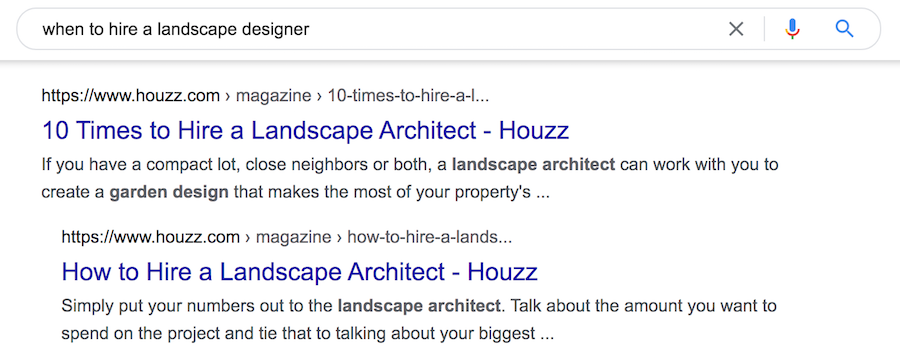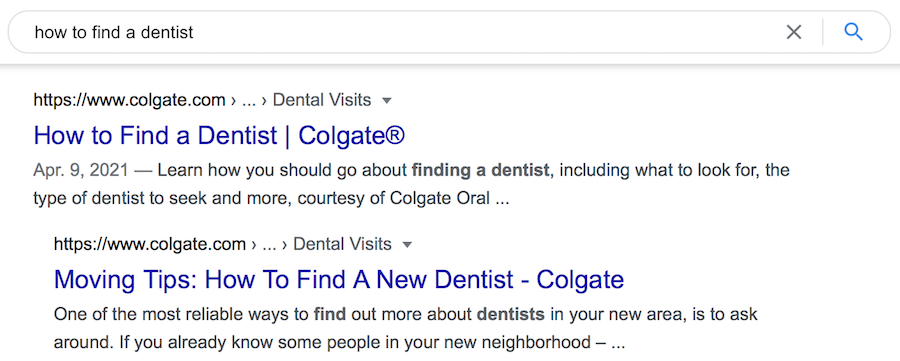Online marketers, SEOs, content publishers, and a few lucky (some unlucky) business owners have noticed a change in Google search results this month. Google is now stacking listings on Google Page 1 for certain domains/websites, with indented results like this:

Another example:

The outcome, is that a number of websites are receiving more than one result on Google Page 1. This is pushing competing content creators down the page. Owners/managers of any business website that receives stacked and indented results on Google can see a clear benefit.
It’s important to note that this is not the same as the results you see when Google displays a breakdown of a website’s subcategory items (services, etc.). That is the work of structured data and schema markup, which has been around for over a decade (since 2011). Instead, this is something entirely different, and pretty exciting for businesses that devote a lot of effort towards content creation. While the examples above feature enterprise companies, smaller businesses and content publishers are equally benefiting from the search engine results page (SERP) update.
Is there anything you can do to experience the same for your website? Unlike with structured data and schema markup, there is no coding work to be done. This is a strictly content focused. That said, pumping out weekly blog posts on its own is not enough. In addition, there is no guarantee that your website will receive stacked and indented Google results. What you can do, is significantly increase the likelihood that you will. Here’s what you need to do.
How to Give Your Business Website’s Content a Better Shot at Enjoying the New Stacked and Indented Results on Google Page One
Post New Content at Least Once Per Week
If your website is not already producing a weekly blog, the time to start is now. The math is simple. The more articles you have on your website, the greater the likelihood that one or more will get picked up and displayed with indented results on Google SERPs. You may even receive three or more indented results for one search query, sending competitors even further down the hole. There’s a caveat, however. The content must be original, informative, helpful to consumers, media-rich (images/graphics), and search engine optimized using targeted title tags and meta-descriptions. The update also seems to prefer articles that deliver content via lists (i.e. Top 10, etc.) or are at least broken down into a structured heading format, just like this article.
Link Articles Together
Another thing that SEO experts are noticing is that articles receiving stacked and indented search results link to, or are linked from, the top-level articles above them (from the same domain). This is logical, as it provides searchers with more than one result from the same authority for a more in-depth answer to their query.
When creating content, link articles together when they relate to one another. For instance, an automobile dealership could create an article about the Best Minivans for Families, and then another titled Best Vehicles for Families, with the more more general (vehicles) article linking to the more targeted (minivans) version. Lets look to another industry as an example. A mortgage brokerage could write an article titled How to Use Home Equity to Buy a Second Home and follow that up with another titled Using Home Equity to Buy a Vacation Property, linking one to the other.
In addition, revisit a given topic when justified, and link the old article to the new one. Let’s look to one of our favorite industries for yet another example. A winery could produce a blog post titled Best Wines for a Summer Wedding, but as vintages change with each harvest, the recommendations may look different from one year to the next. As a result, a winery could produce this post each and every year, linking each new article to its predecessor.
Think of your content strategy as weaving a web from one concept, topic, or theme to the next. The more your articles connect to one another, the more exposure they may receive on Google via this new update.
The only way for your company’s website to reap the benefits of this update and push competitors down Google SERPs is to produce a lot of content. And to reiterate, this content must be original, informative, helpful, media-rich, and search engine optimized. In other words, you’ve got a lot of work to do. It’s not easy to pull together 800-1200 articles that meet the above criteria at least once per week. But that’s what we’re here for. Learn more about our SEO content marketing services and contact us for a FREE consultation today.

